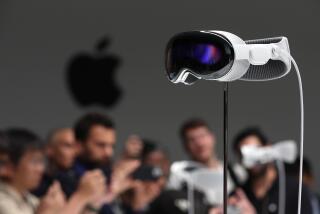New Name for an Old Concept
- Share via
Microsoft’s eHome briefing was like deja vu all over again. I liked what I heard, but I could swear I’d heard it before.
On Nov. 26, Microsoft gathered journalists, analysts and employees on its Silicon Valley campus to unveil its strategy for the connected home. It was an interesting presentation that lacked one thing: specifics.
Microsoft Vice President Mike Toutonghi played a video showing a high school student named Jenna interacting with a friend via her PC. Instead of typing, the two used the PC as a video phone. They collaborated on a class project--a movie they were co-producing--and then they played games together.
In many ways, the demonstration looked a bit like the Knowledge Navigator described by former Apple Chief Executive John Sculley in his 1987 book, “Odyssey: Pepsi to Apple.” Like Sculley’s Knowledge Navigator, the gadgets shown in Microsoft’s video aren’t real products--just concepts.
But 14 years of technology innovation can make a huge difference. What I saw at Microsoft didn’t look all that futuristic. As Toutonghi pointed out, all the technologies to make it happen are already in place, even if the finished products are still unformed.
PC-based voice recognition is no longer a pipe dream. It’s a relatively mature technology. Products such as IBM’s $190 Via Voice and Dragon’s $180 NaturallySpeaking Preferred are reasonably good at turning speech into text.
Likewise, videoconferencing has been around for a while. You don’t need tomorrow’s hardware or even a Bill Gates-size budget to afford it. Anyone with a PC and $50 can connect a small digital video camera, such as Logitech’s Quickcam Express, and do their own Web-based videoconferencing or video instant messaging. Indeed, free video messaging is built into Yahoo Instant Messenger and Microsoft’s MSN Messenger.
The part of the demonstration that interested me most was the integration of the PC and the home entertainment system. Toutonghi made a video call to a colleague in Redmond, Wash., who, in turn, showed off a PC-controlled media system that enabled him to use a TV-like remote control to bring up movies, musical tracks, digital photographs and home videos on his TV set. Some of the media were stored on a PC’s hard drive but he also loaded a movie from a DVD jukebox.
Microsoft views home entertainment as a key growth element. The company, whose motto was once “a computer on every desk,” now wants to “empower people through great software, any time, any place and on any device.”
To that end, the company has taken numerous forays into home entertainment, including its UltimateTV personal video recorder partnership with DirectTV, an earlier similar partnership with Dish Network and, most recently, its introduction of the Xbox game console. Although all of these devices contain processors, hard drives, software and other elements found in personal computers, none function much like PCs and, most important, none currently connect to PCs.
But Microsoft wants to change all that by creating a coherent integrated strategy that will enable consumer electronics devices from all vendors to seamlessly connect to a PC and each other.
Microsoft wants all of our digital devices coordinated by a PC running Windows XP. Trouble is, my Windows XP machines can’t even reliably link all the PCs and printers in my home, let alone run my digital universe.
For this vision to become reality, it not only has to be affordable, but it has to be easy to set up and use and totally reliable. It’s hard enough for one company to create a system that consumers will buy into, but even harder to implement an industry standard that works across disparate devices.
*
Technology reports by Lawrence J. Magid can be heard from 2 to 3 p.m. weekdays on the KNX-AM (1070) Technology Hour. He can be reached at larry.magid@latimes.com.





